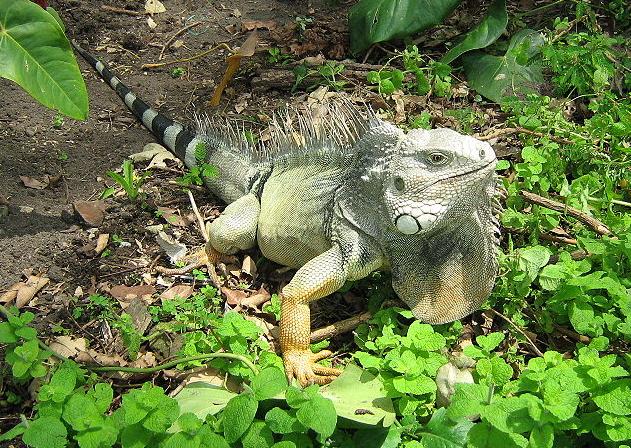
The iguana is a reptile of the family iguanidae, class sauropsid, order squamata, squamate. The name iguana comes from the Taino language iwana.
The genus Iguana, first described by Joseph Nicolaus Laurenti in 1768, includes two species: the green iguana(Iguana iguana), from Mexico, Central and South America, and the Caribbean iguana(Iguana delicatissima), which inhabits the Caribbean islands.
Both species are endemic to the tropical region of the American continent. The Caribbean iguana differs from the green iguana in that it is smaller and lacks the subtympanic scale.

Dr. Rafael Cartay is a Venezuelan economist, historian, and writer best known for his extensive work in gastronomy, and has received the National Nutrition Award, Gourmand World Cookbook Award, Best Kitchen Dictionary, and The Great Gold Fork. He began his research on the Amazon in 2014 and lived in Iquitos during 2015, where he wrote The Peruvian Amazon Table (2016), the Dictionary of Food and Cuisine of the Amazon Basin (2020), and the online portal delAmazonas.com, of which he is co-founder and main writer. Books by Rafael Cartay can be found on Amazon.com
1. The dwarf iguana
A dwarf iguana (Enyalioides laticeps) has been discovered in the Ecuadorian Amazon, specifically in the province of Sucumbíos, about which little is known (Arteaga and Aguiar S.f). Yánez-Muñoz and Oyataga C. (2010) refer to it as Hoplocericadae.
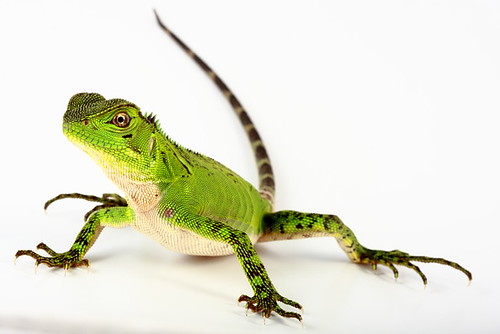


2. Black Iguanas
A black iguana(Callopistes flavipunctatus) has also been identified in Peru , to which healing properties are attributed (Salas 1995).
A black iguana has also been recorded in Mexico, located in the Isthmus of Tehuantepec, in Oaxaca. It is Ctenosaura pectinata (Vargas 2001).
3. The Caribbean Horned Iguana
Another species of iguana is Cyclura nubile nubila, a strong, skilled runner and jumper, which lives on the island of Cuba, or the species Cyclura cornuta, common in Santo Domingo, today the Dominican Republic and Haiti, which has a horn on its nose (Bedia S.f.).

4. The green iguana
The green iguana, the most common, measures between 0.70 and 2 m in length, considering the measurement from the head to the end of the tail. The green iguana averages 1.5 m in length and weighs 15 to 17 kg.

The color of its skin is emerald green, with highlights and streaks of various colors. It presents vertical greenish-gray striations or bands all over the body.
Adult males turn grayish-green, which turns orange during the reproductive period, while adult females remain green.
The body of the iguana is compact and slender, a little flattened laterally. The head of the iguana is large, rounded anteriorly, with two visible tympanic membranes, one on each side.
Tuber Iguana
Below these membranes is a large whitish auricular or subtympanic scale, surrounded by a black border. That scale is what is missing in the Caribbean iguana.

On the tympanic scale there is a series of modified scales in the form of tubercles. That is why they also call the green iguana the “tuber iguana”.
The iguana’ s eyes are small, lively, with brown or bronze irises. The iguana has a large dewlap, or ruff, under the jaw.
Teeth are small and numerous, and may erupt again if they fall out. They are the pleurodonts, arranged in the form of a “palisade”, specialized to finely crush leaves and flowers.
The language
The tongue is unique, not forked, fleshy, pink and protruding. They move it, “licking”, to capture and retain odoriferous particles from the environment, which are analyzed by Jacobson’s organ, located under the palate.
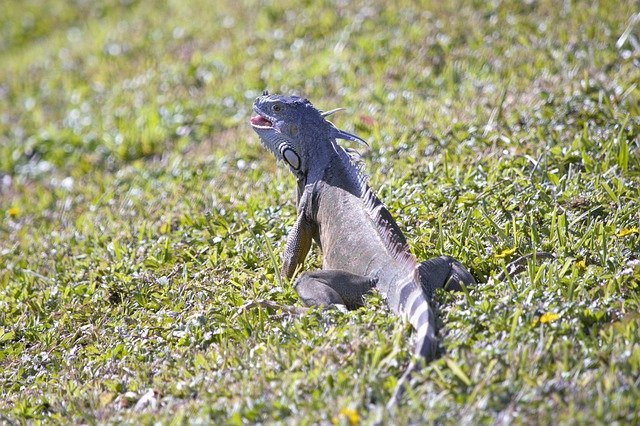
Sexual characteristics
The sexual characteristics of the iguana are the dewlap (more developed in the male) and the height of the spines, but they are difficult to see in young specimens, as they are only noticeable after the first year of life.
Thorns
The green iguana has a series of spines running down its back to its tail. Behind the neck there are raised scales, known as tubercular scales.
It has a crest on the neck and dorsum, and a group of spines under the jaw. It has four legs, two front legs and two hind legs, longer than the previous ones.
Legs
There are four fingers on each limb. At the rear, the fourth toe is longer, to give it stability and enhance its arboreal movements.
Their legs end in strong, hard, sharp claws that allow them to quickly climb trees and unload their food.
Tail
Its tail, longer than its body, 60% of its body length, is used as a defensive weapon against predators. But in captivity the tail is less long, because it breaks easily, and the replacement one does not reach the length of the original one (Millefanti 2016).
Growth
The iguana grows rapidly: at least 1 m long in three years.
Evolution of the iguana
It is an animal of very ancient ancestors, in the Carboniferous stage, about 300 million years ago, although they began to resemble a lizard from the Jurassic, about 180 million years ago.

The fossils that remind us of today’s iguanas date back to the late Cretaceous, about 120 million years ago.
Some consider, perhaps mistakenly, that the iguanadon (Iguanodon bernissartensis) is a remote ancestor of iguanas.
The iguanodont
The iguanodon is an ornithopod and herbivorous dinosaur, about 12 to 14 m long and weighing about 3 tons, which lived in the early Cretaceous period, from 126 to 113 million years ago.

It was characterized as a bipedal animal, with large claws on its thumbs and long fifth prehensile toes that it used to forage for food.
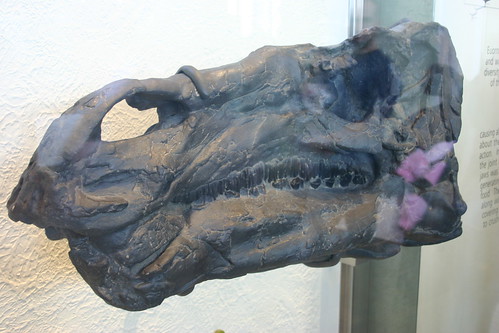
Its name iguanodont comes from iguana and don or donte, which means tooth. It was given the name iguanodont because the huge fossil had iguana-like teeth, appropriate for an herbivorous animal.

The iguana, however, has the appearance of a very primitive animal, strong, armored, with very rough skin, reminiscent of prehistoric animals as they have been reconstructed and represented.
Ecdisis
Iguanas molt periodically, which is known as ecdysis.
It changes its skin, keeping its hard scales.
Poikilotherm or ectotherm?
It is a cold-blooded animal, which some experts consider to be poikilothermic, that is, it has the ability to vary its internal temperature, adjusting it to the temperature of the environment in which it finds itself, to facilitate its survival.
Other specialists consider that the iguana is not exactly poikilothermic, but ectothermic, i.e., it can partially regulate its body temperature.
Sexual Disformity
The iguana presents a clear sexual diformism, in relation to body size: male specimens are longer than females (Sánches & Grings 2018).
Nervous system of the iguana
The nervous system of reptiles has two smooth cerebral hemispheres, with two highly developed olfactory and optic bulbs.
Hence the sharpness of their sense of smell and sight. The spinal cord reaches to the tip of the tail, which is not the case in mammals. As it may lose its tail due to fracture, the iguana may feel its spinal cord functions affected.
The Super-senses of the iguana
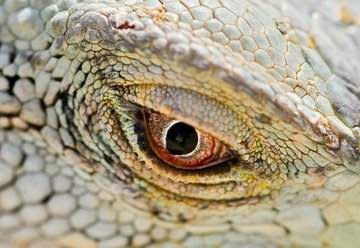
The view
The iguana has highly developed senses of sight and hearing, which is an enormous advantage for fleeing when in dangerous situations.
The ear
They perceive the movement of other beings at considerable distances, which keeps them in constant alarm. It also has an excellent sense of hearing.
Your ear/eardrum is a structure located near your eyes.
The iguana’s ear lacks a pinna, which is present in most mammals.
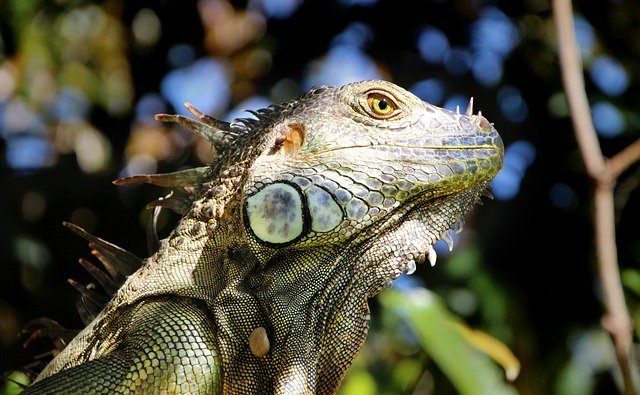
The iguana has an external tympanic membrane, which allows it to capture sounds. Unlike snakes, which only have inner ears, preventing them from picking up sounds. They can only pick up vibrations.
Eyelids
The iguana has three eyelids. One upper, one lower and a third eyelid, which is known as the nictitating membrane.

The third eye of the iguanas
It has a third eye, which appears as a small grayish eye, with no eyelid around it, and located on the top of the head, right in the middle.
It is a pale colored circle that lacks pigment to allow light to pass through. This third eye does not allow normal vision, but informs the iguana about the presence of the sun and clouds, as well as the intensity of the sun’s rays, without the animal having to raise its neck and expose its vulnerable parts.
This third eye, or pineal eye, helps the iguana to orient itself and regulate its daily cycles, which depend on whether it is day or night.
It functions as a solar compass. If covered, the reptile loses its way. That pineal eye is reminiscent of the pineal gland in humans, which did not develop as a third eye, but as an organ that helps regulate our sleep cycles.
The third eye is not found in mammals, but in fish, amphibians and snakes.
Internal organs
The iguana, like reptiles, has only one cavity, called coelomatics, for its lungs and heart.
Below the lungs is the liver. It lacks a diaphragm, therefore it does not cough, and has no expulsion or protective cough function.
For this reason, respiratory diseases in iguanas are very serious.
Saurians have two lungs, something similar to that of mammals. The iguana’s heart is located very close to the base of the neck, and is divided into three chambers, not four as in mammals.
That is, in two atria and one ventricle, which is divided, in turn, into three cavities: pulmonary, venous and arterial. The circulatory system of the iguana comprises two aortas and a particular renal portal venous system (Millefanti 2016).
Habitat
The iguana is distributed in the tropical regions of the American continent. It was believed that the distribution of the green iguana was not total in South America, because there was no evidence of its existence in Bolivia, which was finally recorded in 2011 (Aguilar-Kirigin 2011).
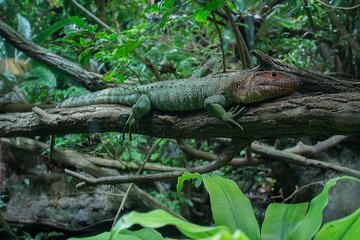
It is found in U.S. territory because it was introduced in Florida and the Hawaiian Islands. The iguana is a saurian that adapts easily to rainy, dry and very sunny areas. It is found in humid areas with abundant vegetation, preferably in a temperature range between 25 and 28 ° C. It likes to be near rivers and lagoons.
Territoriality
The alpha male, the highest ranking and the one followed by the others, jealously defends his territory, wagging his tail and widening his dewlap.

But this territoriality is only expressed when they are in the wild, in their natural environment, and not in captivity.
Being in captivity causes them a lot of stress, and changes a lot of their usual behavior. They usually become aggressive, despite being a calm animal under normal conditions.
They use their tails to defend themselves, but also to balance on tree branches or to stabilize themselves in the water, as they are excellent swimmers.
Feeding
The iguana is herbivorous, feeding on leaves, flowers, fruits and vegetables, and eating insects can be toxic, as recommended in pet iguana husbandry manuals.
Young iguanas may eat several times a day, but adult iguanas usually eat only once every 24 hours.
Young specimens have a tendency to coprophagy, ingesting the feces of other iguanas in order to develop their intestinal flora (Millefanti 2016; Lara-López, González-Romero 2002).
The iguana has a structured digestive system so that it can easily ingest and digest the vegetables in its diet. It is very long, and is divided into large compartments.
The iguana has a urinary bladder, as do turtles, and unlike other saurians, snakes and birds. Feces, urine, eggs and sperm do not go directly outside, but are first deposited in an internal chamber called the cloaca.
Reproduction
Iguanas reach sexual maturity at about 16 months of age. They perform courtship before mating, resorting to head and tail movements. The male then mounts the female. The male has hemipenes, folded in their pouches.

Photograph taken on Isabela Island Source: Charles J Sharp [CC BY-SA].
Saurians and snakes are the only vertebrate animals that possess two copulatory organs. Only one is used during mating. The testicles are two and internal. Females, on the other hand, have two internal ovaries.
Delayed amphigonia
The female iguana can keep, after mating, the male’s sperm in the wall of the oviduct or seminal receptacle for two or three years. During this time the female iguana can lay fertile eggs, because the sperm remains active. This phenomenon, which also occurs with the female turtle, is known as delayed amphigony.
Reproduction is oviparous, and the egg completes its embryonic development externally. The female can lay 20 to 70 eggs in each clutch. Egg incubation lasts from 60 to 110 days.
Playback mode
In the wild, the female builds a nest by digging a deep hole in the soft ground, usually in the sand, which she then covers with soil, to hide it from predators.
An iguana can live between 15 to 20 years, depending on whether it lives in the wild or in captivity. In captivity, they live longer than in the wild. Even longer life spans have been reported.
Diseases of iguanas in captivity
Iguanas in captivity tend to suffer from metabolic bone disease, due to lack of exposure to direct light, ultraviolet rays, and a diet poor in calcium and vitamin D3, so iguanas raised as domestic pets must be provided with these elements.
This disease deforms their spine, as well as their jaw, and makes them prone to constant fractures. Another disease, related to reproductive capacity, is dystocia, which occurs when eggs cannot hatch and get stuck in the oviduct.
An iguana produces eggs, even if it has never had contact with a male. In this case, they are non-fertile eggs.
Behavior
The iguana is a diurnal, heliotropic (turns towards the sun) and heliothermic (regulates its body temperature, adjusting it to the environment) animal.
In the wild it is a solitary reptile, very calm, but its behavior changes notably in captivity. Because they cannot express their territoriality, they become aggressive, and become restless in the presence of other iguanas.
Iguana as a pet
The pet iguana transmits bacteria or can receive bacteria when it is excessively handled or kissed.
It is very important to include fruits in their daily diet, and to complement their diet with nutritional supplements, especially vitamins.
The iguana has “salt glands”, which are structures that end in the nasal cavity and are responsible for eliminating excess mineral salts that have been ingested in the diet. It eliminates saline liquids in this way, and does so by sneezing, which should not be confused with a respiratory pathology.
The iguana is a sedentary animal, spending most of its time in the trees. However, it can make medium distances when it moves during the nesting period.
The female travels about 3 km to reach the river beach, looking for a suitable place in the sand to deposit her eggs (Morales-Mavil, Vogt, Gadsden -Esparza 2007).
A look at the iguanas of the Galapagos Islands
In the Galapagos Islands, belonging to Ecuador, there is a genus with three species of land iguanas: Conolophus subáristatus, C. pallidus, C. marthae, different from the marine iguanas (Amblyrhynchus iguanas). C. cristatus is distributed on 4 islands; C. pallidus is endemic to the island of Santa Fe, and C. marthae, which lives above 500 meters above sea level, is found on the slopes of Wolf volcano on Isabela.

Source: Samuel Meylan[CC BY-SA].
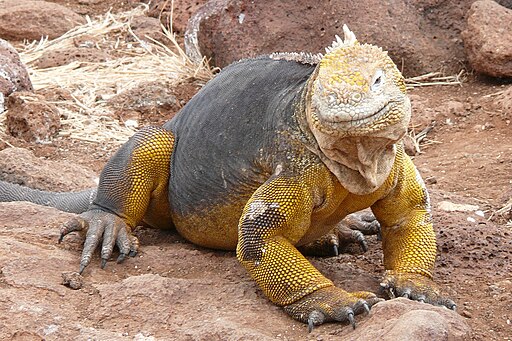
Source: Haplochromis[CC BY-SA].

Source: Benjamint444[GFDL 1.2].
One of them, C. marthae, presents a pinkish color, with a tail and black bands on the body (Márquez B., Muñoz H., Gentile G., Tapia A., Javier Zabala, Naranjo, Uerena 2019).
Marine iguanas ( Amblyrhnychus iguanas) are the only iguanas whose energy is derived from marine herbivory.
Hybridization between iguanas has occurred on the islands, to the point that a species resulting from this hybridization between land iguanas(cristatus) and marine iguanas(A. iguanas. The result is the species A. cristatus (Snell and Marquez 2002; Danulat and Edgar 2002).

One of the main characteristics of marine iguanas is that they depend mainly on the food they get from the sea, particularly seaweed, which they search for by diving to a depth of 12 meters.

They may also feed on plants found among the rocks along the coast. Algae are abundant when the sea water temperature is warm. But if food becomes scarce, which happens when the water gets very cold, adult marine iguanas shrink, absorbing their bones as a survival strategy.
As the food supply increases again, the iguanas recover their size. Another fact of interest is that iguana hatchlings feed mostly, during the first two months of life, on adult feces to obtain the microorganisms they need for digestion (Guerra-Guerra and Rodríguez-Guerra 2016).
BIBLIOGRAPHY .
Aguilar-Kirigin A.J. 2011. Iguana iguana (Linnaeus 1758)(Squamata: Iguanadae). Cuadernos de Herpetología, 25 (1), 25-26.
Arteaga A., Aguiar G. S.f. Amazon Dwarf Iguana. Journal of the Colombian Academy of Exact, Physical and Natural Sciences. 13, 149-199.
Bedia F. From prehistory. Revistasexcelencias.com/Caribe/un-caribe-differente/historia /iguana-desde-la-prehistoria.
Danulat E, Edgar G.J. 2002. Galapagos Marine Reserve. Biodiversity Baseline. Puerto Ayora, Santa Cruz, Galapagos.
Guerra- Guerra E, Rodríguez-Guerra A. 2016. Amblyrhynchus cristatus. In: Torres-Carvajal O, Pazmiño-Otamendi G, Salazar-Valenzuela D. Reptiles of Ecuador . Quito: Museum of Zoology. Pontificia Universidad Católica del Ecuador.
Lara-López M.del S., González-Romero A. 2002. Feeding of Iguana iguana (Squamata: Iguanidae) in La Mancha, Veracruz, Mexico. Acta Zoológica Mexicana (online), No. 85, 139-152. ISSN 2448-8445.
Márquez B, C.M., Muñoz H., E.A., Gentile G., Tapia A, W.H., Javir-Zabala F., Naranjo S.A., Uerena A.I. 2010. Population status of the land iguanas Conolophus subcristatus, C.palludis, C. marthae: Squamata, Iguanidae . Galapagos Islands. Technical Bulletin Zoology Series. Vol. 9 (6), 19-37.
Millefanti M. 2016. The iguana. Mexico: Editorial De Vecchi, S.A.
Morales-Mávil J.E., Vogt R., Gadsden-Esparza H. 2007. Displacements of the green iguana, Iguana iguana. Journal of Tropical Biology. Vol. 55 (2).
Salas A.W. 1995. Peruvian herpetofauna: an overview of research, conservation and management. Biotempo, 2, 125-137. December.
Sanchez V.Q.A., Grings D.R. 2018. Movement and habitat use of Iguana iguana (Linnaeus 1758) in an urban second growth Amazonian forest fragment in Brazil. Herpetology Notes. Vol. 11, 93-96.
Snell H.L., Márquez C. 2002. Marine iguanas. https://www.darwinfoundation.org .
Vargas Z. 2001. Valuation of terrestrial vertebrates by Huares and Zapotecs from the Isthmus of Tehuantepec, Oaxaca, Mexico. http://ecosas.repositorioinstitucional.mx/jspui/handle/ 1017/1476.Yánez-MuñozM, Oyataga C., L. 2010. Diversity of the herpetofauna in the La Balsareña-Sozoranga sector, Sucumbíos Province, Ecuador. Researchgate.net /profile/Mario_Yanez-Muñoz/publicatio292158428_DIVERSIDAD_DE_LA_HERPETOFAUNA EN_EL_SECTOR_LA_ BALSARINA_SOZORANGA-PROVINCIA-SUCUMBIOS-ECUADOR.
This post is also available in:
![]() Español (Spanish)
Español (Spanish)

